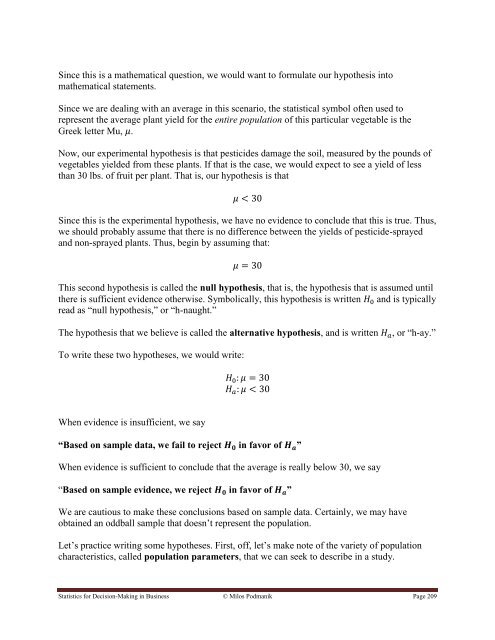Statistics for Decision- Making in Business - Maricopa Community ...
Statistics for Decision- Making in Business - Maricopa Community ...
Statistics for Decision- Making in Business - Maricopa Community ...
You also want an ePaper? Increase the reach of your titles
YUMPU automatically turns print PDFs into web optimized ePapers that Google loves.
S<strong>in</strong>ce this is a mathematical question, we would want to <strong>for</strong>mulate our hypothesis <strong>in</strong>to<br />
mathematical statements.<br />
S<strong>in</strong>ce we are deal<strong>in</strong>g with an average <strong>in</strong> this scenario, the statistical symbol often used to<br />
represent the average plant yield <strong>for</strong> the entire population of this particular vegetable is the<br />
Greek letter Mu, .<br />
Now, our experimental hypothesis is that pesticides damage the soil, measured by the pounds of<br />
vegetables yielded from these plants. If that is the case, we would expect to see a yield of less<br />
than 30 lbs. of fruit per plant. That is, our hypothesis is that<br />
S<strong>in</strong>ce this is the experimental hypothesis, we have no evidence to conclude that this is true. Thus,<br />
we should probably assume that there is no difference between the yields of pesticide-sprayed<br />
and non-sprayed plants. Thus, beg<strong>in</strong> by assum<strong>in</strong>g that:<br />
This second hypothesis is called the null hypothesis, that is, the hypothesis that is assumed until<br />
there is sufficient evidence otherwise. Symbolically, this hypothesis is written and is typically<br />
read as “null hypothesis,” or “h-naught.”<br />
The hypothesis that we believe is called the alternative hypothesis, and is written<br />
, or “h-ay.”<br />
To write these two hypotheses, we would write:<br />
When evidence is <strong>in</strong>sufficient, we say<br />
“Based on sample data, we fail to reject <strong>in</strong> favor of ”<br />
When evidence is sufficient to conclude that the average is really below 30, we say<br />
“Based on sample evidence, we reject <strong>in</strong> favor of ”<br />
We are cautious to make these conclusions based on sample data. Certa<strong>in</strong>ly, we may have<br />
obta<strong>in</strong>ed an oddball sample that doesn‟t represent the population.<br />
Let‟s practice writ<strong>in</strong>g some hypotheses. First, off, let‟s make note of the variety of population<br />
characteristics, called population parameters, that we can seek to describe <strong>in</strong> a study.<br />
<strong>Statistics</strong> <strong>for</strong> <strong>Decision</strong>-<strong>Mak<strong>in</strong>g</strong> <strong>in</strong> Bus<strong>in</strong>ess © Milos Podmanik Page 209
















